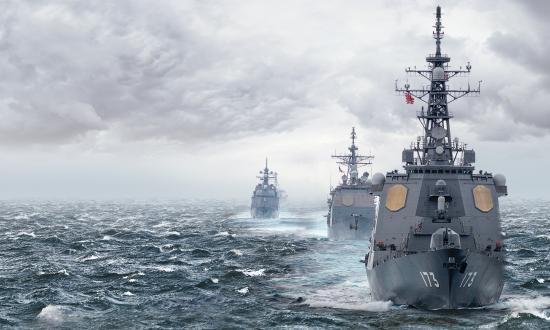"Ninety thousand tons of diplomacy.” This nickname for U.S. aircraft carriers originated as a commercial slogan, but American navalists have been quick to embrace it.1 The United States already has deployed these floating instruments of diplomatic power in great power competition. For example, a 2019 deployment of two carrier strike groups to the Mediterranean Sea was, according to then-Ambassador to Russia Jon Huntsman, intended to signal to Russia that “it must cease its destabilizing activities around the world.”2
Since then, however, Russia has continued its aggression toward Ukraine, doubled down in Syria, deployed aircraft to Libya, and conducted repeated and often unsafe intercepts of U.S. aircraft. The two-carrier deployment did little (if anything) to moderate its behavior. As Russian naval analyst Mikhaeil Barabanov has explained, “Moscow is generally indifferent to an American carrier in the Mediterranean, or even two or three . . . [because] no one in Russia seriously believes in the possibility of a conventional military conflict with the United States.”3
Nor has naval presence had much effect on the United States’ other great power rival. As China has built out and militarized disputed land features in the South China Sea, the United States has responded by conducting freedom of navigation operations in nearby waters—a record number in 2019.4 Meanwhile, Chinese militarization there continues uninterrupted.
The reason that naval presence operations fail to deter aggressive Russian and Chinese behavior is simple: the presence of U.S. warships is not backed by a credible threat of force. History is replete with examples of effective naval diplomacy, but the most successful have incorporated “the use or threat of limited naval force.”5 This is gunboat diplomacy, and history shows that it works.
Gunboat Diplomacy
For the United States and Great Britain, the century before World War I was characterized by effective uses of naval power in support of national strategy. To influence rivals’ behavior, warships did more than show the flag. Gunboats had guns—and were prepared to use them.
In 1863, the Royal Navy backed a British demand for reparations from Brazil for the plundering of the wrecked merchant vessel Prince of Wales. When Brazil refused, Royal Navy warships seized five Brazilian vessels.6
Britain also joined Germany in the 1902–3 naval blockade of Venezuela to coerce the latter into paying its debts. The Anglo-German force seized—and, in some cases, destroyed—Venezuelan warships. After only two months, Venezuela acquiesced and agreed to begin repaying its creditors.7
The United States practiced gunboat diplomacy in Venezuelan waters in 1899. Accompanied by Francis Loomis, the U.S. minister, the USS Wilmington (PG-8) sailed up the Orinoco River, transiting a region in which the United States sought to expand trade. The Wilmington sailed with permission, but Loomis backed his diplomacy with frequent demonstrations of the ship’s Colt machine guns. “This gun, firing some 500 shots a minute, produced a vivid impression here,” he wrote. “I made a point of having this gun fired anytime there were any army officials on board.”8
Naval power reinforced diplomacy to help achieve national strategic objectives. It sometimes required use of force, such as a blockade or the seizure of foreign vessels. In other instances, a threat of force was sufficient. In all cases, it was the ability to project force—not mere presence—that achieved results.
Presence or Commitment
In April 2020, a China Coast Guard vessel rammed and sank a Vietnamese fishing boat in the South China Sea.9 A few weeks later, the USS Montgomery (LCS-8) and USNS Cesar Chavez (T-AKE-14) “conducted a presence operation in the South China Sea.”10 The contrast is striking.
A fishing boat captain may pause when a U.S. destroyer steams by, but he is unlikely to change his behavior as a result. In contrast, China’s willingness to back its maritime claims with force will get his full attention.
When a navy wishes to influence a rival’s behavior, presence is a necessary condition but not a sufficient one. In the era of renewed great power competition, as in the era of gunboat diplomacy, naval presence most effectively supports diplomacy when accompanied by a credible threat of force. While the decision to threaten a rival state—particularly with respect to nuclear-armed great power rivals—involves risk, gunboat diplomacy has been effective in the past. Perhaps it could be again.
1. The slogan appears to have originated in advertising for the Northrop Grumman Corporation.
2. Matthew Bodner, “U.S. Rolls 100K Tons of International Diplomacy into the Med: Will Russia Get the Message?” Defense News, 26 April 2019.
3. Bodner, “U.S. Rolls 100K Tons of International Diplomacy into the Med.”
4. John Power, “U.S. Freedom of Navigation Patrols in South China Sea Hit Record High in 2019,” South China Morning Post, 5 February 2020.
5. Kevin Rowlands, “‘Decided Preponderance at Sea’: Naval Diplomacy in Strategic Thought,” Naval War College Review 65, no. 4 (Autumn 2012): 90.
6. Beatriz Gallatri Mamigonian, “Building the Nation, Selecting Memories,” conference paper, Yale University, 2010.
7. George Arthur Boston, “A Doctrine Revisited: The Venezuelan Crisis of 1902 and the Roosevelt Corollary,” master’s thesis, Western Michigan University, June 1989.
8. Paul Simoes de Carvalho, “Gunboat Diplomacy on the Orinoco,” Naval History 17, no. 4 (August 2003).
9. Khanh Vu, “Vietnam Protests Beijing’s Sinking of South China Sea Boat,” Reuters, 4 April 2020.
10. Dzirhan Mahadzir, “U.S. Sends Warships on Patrol Near South China Sea,” USNI News, 8 May 2020.








